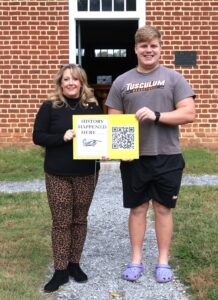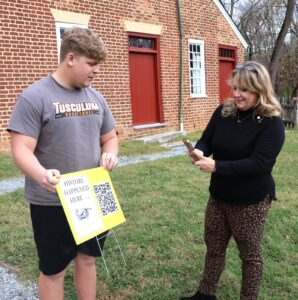GREENEVILLE – Campus visitors during major events at Tusculum University now have a chance to learn more about the higher education institution’s special heritage through a class project undertaken by history students.

Dr. Angela Keaton, left, and student Kenton Cobble hold one of the signs.
With guidance from Dr. Angela Keaton, professor of history, the students have created 14 yard signs that are placed at strategic locations on the Tusculum grounds. All of the yellow signs have a header that says, “History happened here” and a QR code people can scan to connect to a web page that provides additional detail about Tusculum.
“Our history program embraces every opportunity to provide students with hands-on learning to develop skills necessary for their discipline and future careers,” Dr. Keaton said. “This project provided them with an excellent way to gain experience working with archival material and making it accessible to the public to tell the story of Tusculum University’s past.”
So far, the signs have been deployed on campus during the Old Oak Festival in the spring and Homecoming in the fall. Dr. Keaton wants to continue the project by either expanding the current one or choosing a new focus, and she would like to have permanent signage that would enable everyone to take an interactive history tour at any time.
The signs were the work of Dr. Keaton’s Gender History class. The students picked all of the topics and photos that were used to create the interactive tour. Students who participated in the project were Kenton Cobble, BriAnna Higgins, Sydney May, Max Mullins, Samantha Nelson and Todd Wallin.
The 14 web pages that were created were the project home page, the iconic Old Oak Tree, athletics, student clubs, veterans, debate tradition, graduations, amphitheater, Tusculum Farm, Samuel W. Doak sermon, civic engagement, student fun, programs of study and May Day. The pages are concise and feature a summary and photos that relate to the subject.
“We had so much fun rummaging through the university’s archives to find interesting and entertaining pictures that would act as windows into Tusculum’s past,” Dr. Keaton said. “Photos ranged from the old amphitheater near Tredway Hall and WWII-era student veteran housing to 1890 baseball players and May Day celebrations. My personal favorite is the Samuel W. Doak sermon in which he explains how to raise children properly.”

Dr. Angela Keaton, right, scans the QR code on one of the signs held by student Kenton Cobble.
Dr. Keaton said this project replaced a traditional research paper for this class.
“Students would still get research experience, but the final product would be for public consumption rather than a paper only read by the professor,” she said. “Our students enter many different history-related fields and need experience with delivering historical content in varied formats to diverse audiences. This was a project that would have tremendous benefit to our future educators, researchers, archivists, curators and others. Another goal was to generate additional school pride since students would be sifting through the Tusculum University archives.”
Cobble, a senior pursuing a bachelor’s degree in history, with plans to become a high school history teacher, enjoyed working on the project. He was particularly interested because the signs would be used during the festival and many visitors to campus would have the opportunity to participate in scanning the codes. His goal was to inform those who went to the web pages.
“A lot of times, people will walk around a place and experience it but don’t know the history behind it,” Cobble said. “I think the history is interesting. It’s super easy to overlook some of this stuff, but the way we arranged these signs, all you had to do was take out your phone and you had this history at your fingertips. I was pretty pleased with how it went. We analyzed who scanned the QR codes, and it was a good number of people.”
Dr. Keaton said the connection to the community was important. Many people are aware of the Doak family and the university’s founding in 1794, but she wanted to shine a light on other aspects of Tusculum’s history that might not be as well known.
“In addition to providing students with an experiential learning project, it was very important to me to show the many ways that Tusculum has been an integral part of Greene County and East Tennessee since its founding,” Dr. Keaton said. “By making it an interactive project, it would facilitate engagement with Tusculum and remind people of the school’s long role in engaging with and enriching the broader Greene County community.”
To access to the project’s website, please visit https://akeaton8.wixsite.com/hhhproject24. More details about Tusculum’s history program are available at https://site.tusculum.edu/history/. Additional information about the university is available at www.tusculum.edu.


